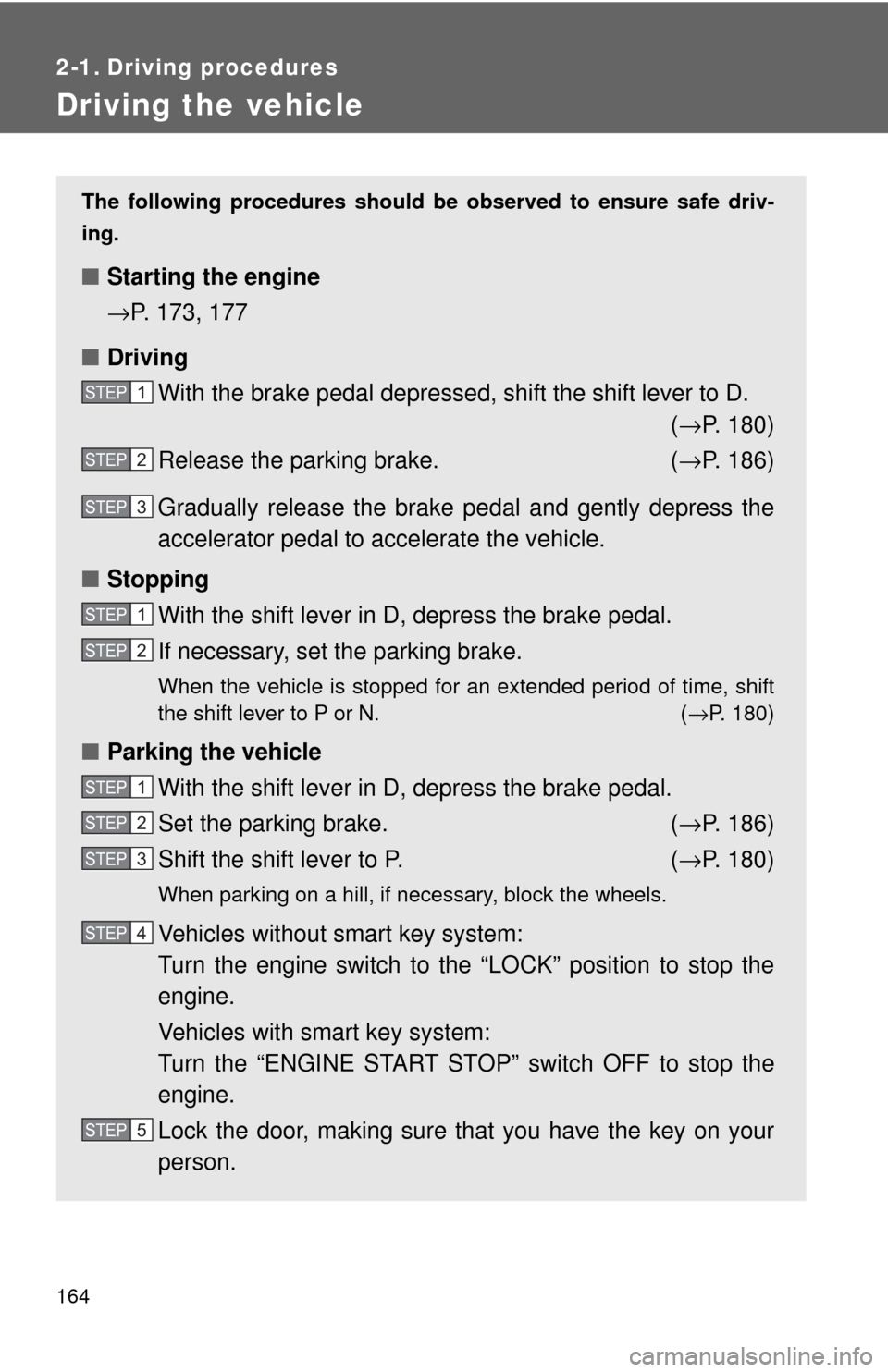Page 122 of 608
122
1-6. Theft deterrent system
Alarm∗
The system sounds the alarm and flashes the lights when forcible
entry is detected.
■ Triggering of the alarm
The alarm is triggered in the following situations.
●A locked door is unlocked or opened in any way other than
using the wireless remote control door lock function or entry
function (vehicles with smart key system). The doors will lock
again automatically.
● The hood is opened while t he vehicle is locked.
● The locked glass hatch is opened in any way other than using
the wireless remote control door lock function or entry function
(vehicles with smart key system).
● The battery is reconnected.
�: If equipped
Page 123 of 608
123
1-6. Theft deterrent system
1
Before driving
■
Setting the alarm system
Vehicles without navigation system
Close the doors and hood,
and lock all doors using the
wireless remote control door
lock function or entry function
(vehicles with smart key sys-
tem). The system will be set
automatically after 30 sec-
onds.
The indicator light changes
from being on to flashing when
the system is set.
Vehicles with navigation system
Close the doors and hood,
and lock all doors using the
wireless remote control door
lock function or entry function
(vehicles with smart key sys-
tem). The system will be set
automatically after 30 sec-
onds.
The indicator light changes
from being on to flashing when
the system is set.
Page 124 of 608
124 1-6. Theft deterrent system
■Items to check before locking the vehicle
To prevent unexpected triggering of the alarm and vehicle theft, make sure
of the following.
●Nobody is in the vehicle.
● The windows and moon roof are closed before the alarm is set.
● No valuables or other personal items are left in the vehicle.
■ Panic mode
→P. 5 6
■ When the battery is disconnected
Be sure to cancel the alarm system.
If the battery is disconnected before canceling the alarm, the system may be
triggered when the battery is reconnected.
■ When using the key to unlock the doors
Deactivate the alarm.
■ Deactivating or stopping the alarm
Unlock the doors using the wireless remote control door lock
function or the entry function (v ehicles with smart key system).
Page 149 of 608

149
1-7. Safety information
1
Before driving
CAUTION
■
Child restraint precautions
●A forward-facing child restraint system may be allowed to be installed on
the front passenger seat only when it is unavoidable. A child restraint sys-
tem that requires a top tether strap should not be used in the front passen-
ger seat since there is no top tether strap anchor for the front passenger
seat. Adjust the seatback as uprights as possible and always move the
seat as far back as possible even if the “AIR BAG OFF” indicator light is
illuminated, because the front passenger airbag could inflate with consid-
erable speed and force. Otherwise, the child may be killed or seriously
injured.
● Do not use the seat belt extender when installing a child restraint system
on the front or rear passenger seat. If installing a child restraint system
with the seat belt extender connected to the seat belt, the seat belt will not
securely hold the child restraint system, which could cause death or seri-
ous injury to the child or other passengers in the event of an accident.
● Do not allow the child to lean his/her head or any part of his/her body
against the door or the area of the seat, front and rear pillars or roof side
rail from which the side airbags or curtain shield airbags deploy even if the
child is seated in the child restraint system. It is dangerous if the side air-
bags and curtain shield airbags inflate, and the impact could cause death
or serious injury to the child.
● Make sure you have complied with all installation instructions provided by
the child restraint manufacturer and that the system is properly secured. If
it is not secured properly, it may cause death or serious injury to the child
in the event of a sudden stop or an accident.
■ Child restraint lock function belt precaution
Do not allow children to play with the child restraint lock function belt. If the
belt becomes twisted around a child’s neck, it will not be possible to pull the
belt out leading to choking or other serious injuries that could result in death.
If this occurs and the buckle cannot be unfastened, scissors should be used
to cut the belt.
Page 164 of 608

164
2-1. Driving procedures
Driving the vehicle
The following procedures should be observed to ensure safe driv-
ing.
■ Starting the engine
→P. 173, 177
■ Driving
With the brake pedal depressed, shift the shift lever to D. (→ P. 180)
Release the parking brake. ( →P. 186)
Gradually release the brake pedal and gently depress the
accelerator pedal to accelerate the vehicle.
■ Stopping
With the shift lever in D, depress the brake pedal.
If necessary, set the parking brake.
When the vehicle is stopped for an extended period of time, shift
the shift lever to P or N. ( →P. 180)
■Parking the vehicle
With the shift lever in D, depress the brake pedal.
Set the parking brake. ( →P. 186)
Shift the shift lever to P. ( →P. 180)
When parking on a hill, if necessary, block the wheels.
Vehicles without smart key system:
Turn the engine switch to the “LOCK” position to stop the
engine.
Vehicles with smart key system:
Turn the “ENGINE START STOP ” switch OFF to stop the
engine.
Lock the door, making sure that you have the key on your
person.
STEP1
STEP2
STEP3
STEP1
STEP2
STEP1
STEP2
STEP3
STEP4
STEP5
Page 178 of 608

178 2-1. Driving procedures
■Turning the key from “ACC” to “LOCK”
■ Steering lock release
■ If the engine does not start (vehicles with engine immobilizer system)
The engine immobilizer system may not have been deactivated. ( →P. 115)
■ Key reminder function
A buzzer sounds if the driver’s door is opened, while the key is in the “LOCK”
or “ACC” position to remind you to remove the key.
CAUTION
■When starting the engine
Always start the engine while sitting in the driver's seat. Do not depress the
accelerator while starting the engine under any circumstances.
Doing so may cause an accident resulting in death or serious injury.
■ Caution when driving
Do not turn the engine switch to the “LOCK” position while driving. If, in an
emergency, you must turn the engine off while the vehicle is moving, turn the
key only to the “ACC” position.
Shift the shift lever to P.
(→P. 180)
Push in the key and turn to the
“LOCK” position.
STEP1
STEP2
When starting the engine, the engine
switch may seem stuck in the “LOCK”
position. To free it, turn the key while turn-
ing the steering wheel slightly in either
direction.
Page 206 of 608

206 2-3. Operating the lights and wipers
■Automatic light off system
Vehicles without smart key system
The headlights and tail lights turn off 30 seconds after drivers door is opened
and closed if the engine switch has been turned to the “ACC” or “LOCK”
position.
To turn the lights on again, turn the engine switch to the “ON” position, or
turn the headlight switch off and then back to or .
Vehicles with smart key system
The headlights and tail lights turn off 30 seconds after drivers door is opened
and closed if the “ENGINE START STOP” switch has been turned to
ACCESSORY mode or turned to OFF.
To turn the lights on again, turn the “ENGINE START STOP” switch to IGNI-
TION ON mode, or turn the headlight switch off and then back to or .
■ Customization that can be configured at Toyota dealer
Settings (e.g. daytime running light system) can be changed.
(Customizable features →P. 582)
NOTICE
■To prevent battery discharge
Do not leave the lights on longer than necessary when the engine is not run-
ning.
Page 255 of 608

Interior features3
255
3-4. Using the hands-free phone system (for cellular phone)
Hands-free phone system (for cellular phone)
features .......................... 342
Using the hands-free phone system ................ 346
Making a phone call ......... 353
Setting a cellular phone ............................. 357
Security and system setup .............................. 362
Using the phone book ...... 365
3-5. Using the interior lights Interior lights list ............... 372
• Personal/interior light main switch .................... 373
• Personal/interior
lights .............................. 373
• Interior light .................... 374 3-6. Using the storage features
List of storage features .... 375
• Glove box....................... 376
• Console box ................... 377
• Overhead console .......... 378
• Cup holders ................... 379
• Bottle holders ................. 383
• Auxiliary boxes ............... 384
• Side table ....................... 386
3-7. Other interior features Sun visors ........................ 388
Vanity mirrors ................... 389
Clock (vehicles without multi-information
display) .......................... 390
Conversation mirror ......... 391
Power outlets ................... 392
Seat heaters..................... 396
Armrests........................... 398
Floor mat .......................... 399
Luggage compartment features .......................... 400
Garage door opener......... 406
Compass .......................... 411